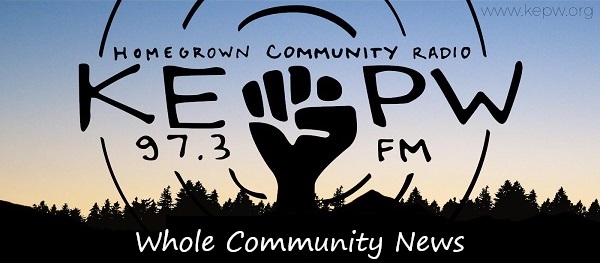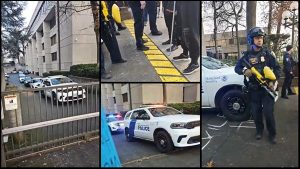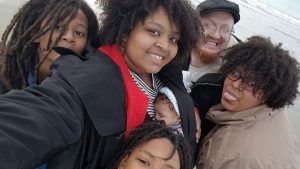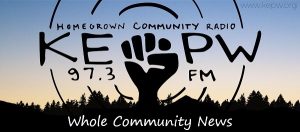Amazon Park emergency water station to celebrate grand opening Sept. 28
5 min read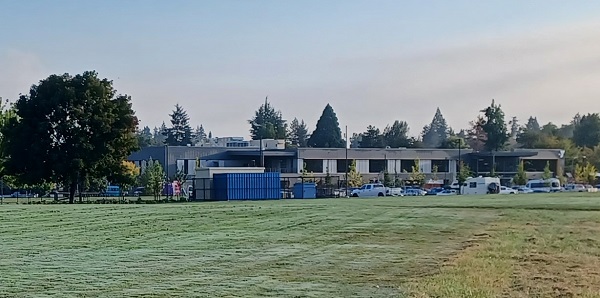
You’re invited to check out the city’s newest emergency water station, this Saturday, Sept. 28.
Claire Wray (EWEB): I’m Claire Wray, and I am a communication specialist at EWEB, and on Saturday, Sept. 28 we’re inviting the public to come out and do a practice demonstration of our newest water station, the Amazon Park emergency water station. It’s located just south of the YMCA campus, and the public is invited from 10:30 a.m. to 1:30 p.m. to come and practice filling water jugs, practice disinfecting emergency water, and learning more about emergency preparedness broadly.
[00:00:50] The water stations are a really important component of emergency preparedness, should an earthquake or other natural disaster take out a part of our water system—for example, the distribution pipelines that deliver water to homes. And so the water stations are meant to provide a temporary safety net so that people can access water while regular service is being restored.
[00:01:15] We like to have these demonstration events because the setup will mirror that of an actual an emergency. So we set up cones and directional signage and have a check-in table.
[00:01:30] The core of the emergency water station is really this very long distribution manifold, and it has several hoses coming out of it. And so attendees will be guided to that distribution station and shown how to activate the hoses to fill up their water jugs.
[00:01:50] After that, they’re routed to a water disinfection table, and there we have bleach and measuring devices. We use one-eighth of a teaspoon. So the recommendation is to use one-eighth of a teaspoon per gallon of water. The jugs that are provided at the emergency water station events are three gallons. So you need three one-eighth teaspoons in there. You let it sit for 30 minutes, at least, to disinfect the water. So, folks will go ahead and go through that process and then be routed out.
[00:02:25] We’ll also have other tables there. The Y is such a nice place for families to go, you know, and spend time, and so when we first conceived this event, that was a big focus, you know, introducing kids to emergency preparedness in a really engaging way and making activities available to them that would be memorable and fun.
[00:02:47] We wanted to have some family-friendly activities available. So we have emergency preparedness stickers and temporary tattoos to give a nod to the water element of the event, and then also coloring sheets for kids.
[00:03:03] Filling the jugs is pretty fun too, actually for families, you know, so that will be great. I did want to mention that we are handing out emergency water jugs, but supplies are limited for those jugs. So it’s ‘while supplies last,’ and we’re providing just one jug per household, so that way we can maximize the number of jugs that go to different households.
[00:03:27] And then, the city’s CERT team (the Community Emergency Response Team) also provides a number of volunteers for these events, and that’s important just so that we have enough people to help attendees, but also CERT volunteers learn about how the station is set up, how to set up that distribution manifold and the signage to route people through.
[00:03:52] And in the event of a real emergency, you know, CERT will be on the scene and we want to have a lot of practice together, setting these stations up. So, our partners at the Y will also be present as well as the city.
[00:04:05] John Q: The emergency water program is a collaborative effort, with contributions from many local organizations.
[00:04:12] Claire Wray: These emergency water stations really are a collaboration between a ton of different partners. The city let EWEB install the station on Park (Department) land, Amazon Park land. The station connects to the Y’s power resources. The Y has backup power from a generator in case of emergency. So the station will also be connected to that. So it will have emergency power and the fact that we didn’t have to buy land or provide our own power resources is a huge cost savings to the community.
[00:04:45] And so our partners will also be present to really celebrate that collaborative aspect of these stations. It’s a really innovative emergency water station solution that EWEB has come up with for the community, maximizing the resources that we already have, and partnering with the city and other organizations to make these stations happen.
[00:05:13] And so, the Y and the city were really important to the Amazon Park one. At other stations it’s our local school districts who have let us connect to their power resources, and other organizations, like, the Eugene Science Center was a partner in one of these projects. The 4J School District, the Bethel School District and the city of Eugene and the YMCA. So it really is a team effort. And that’s reflected in these demonstration events where you see folks from all different organizations there.
[00:05:39] The morning will open with a short ceremony and ribbon cutting so we have a place for people to gather and then right at 10:30 a.m., we’ll have short remarks from project partners. So that will include an EWEB commissioner, the CEO of the YMCA, and the director of Parks and Open Space from the city. And then we’ll have a ribbon cutting to officially designate the site and then invite folks to fill up water containers.
[00:06:06] John Q: With the completion of the sixth water station, construction will begin on the seventh.
[00:06:12] Claire Wray: This station is our sixth station. There are going to be seven total when the program is complete, and construction of the seventh station at Kennedy Middle School is actually kicking off on Monday. So, by 2025, we’ll have all seven stations complete and that will give the city of Eugene geographically-distributed water station sites that are capable of providing immediate, reliable access to water—to two gallons of water per person per day to everyone in Eugene. We’re keeping it moving and 2025 will be a really great milestone for the program.
[00:06:54] It’s an exciting time, you know, investing right now for a more resilient future for our kids and grandkids, and also, a really big responsibility to do it right. And the (EWEB) water team feels that, and so they’re using best practices in the design of all these projects.
[00:07:09] And Nathan (Endicott) mentioned at the Amazon emergency water station kickoff, he gets calls from other utilities saying, ‘I really like what you guys are doing. You know, could you give me some more information?’ And so that’s really great, too, to be able to chart a path and let other utilities know about what we’re doing that might work for them as well.
[00:07:28] John Q: Check out the family-friendly grand opening of the city’s latest emergency water station this Saturday Sept. 28.
